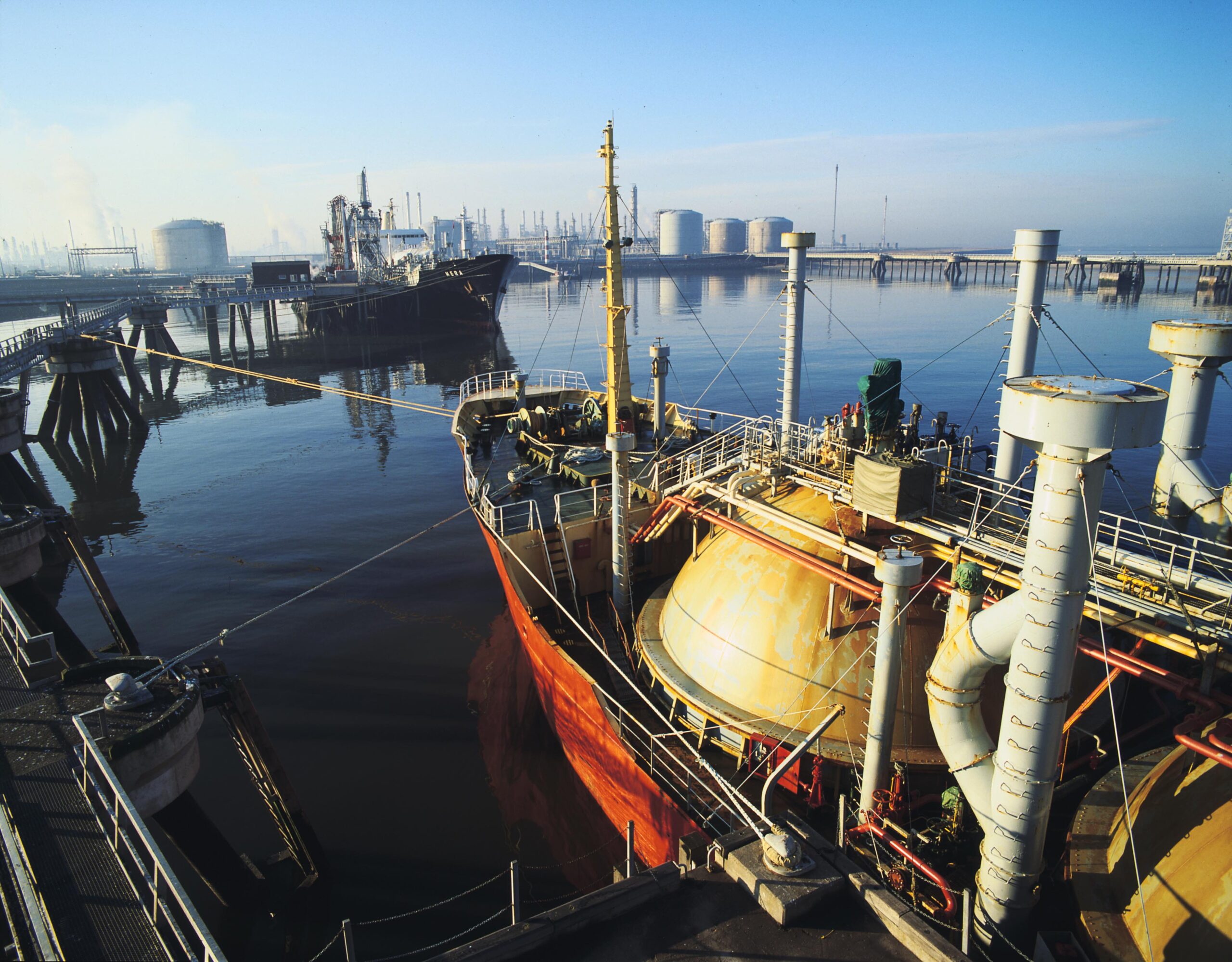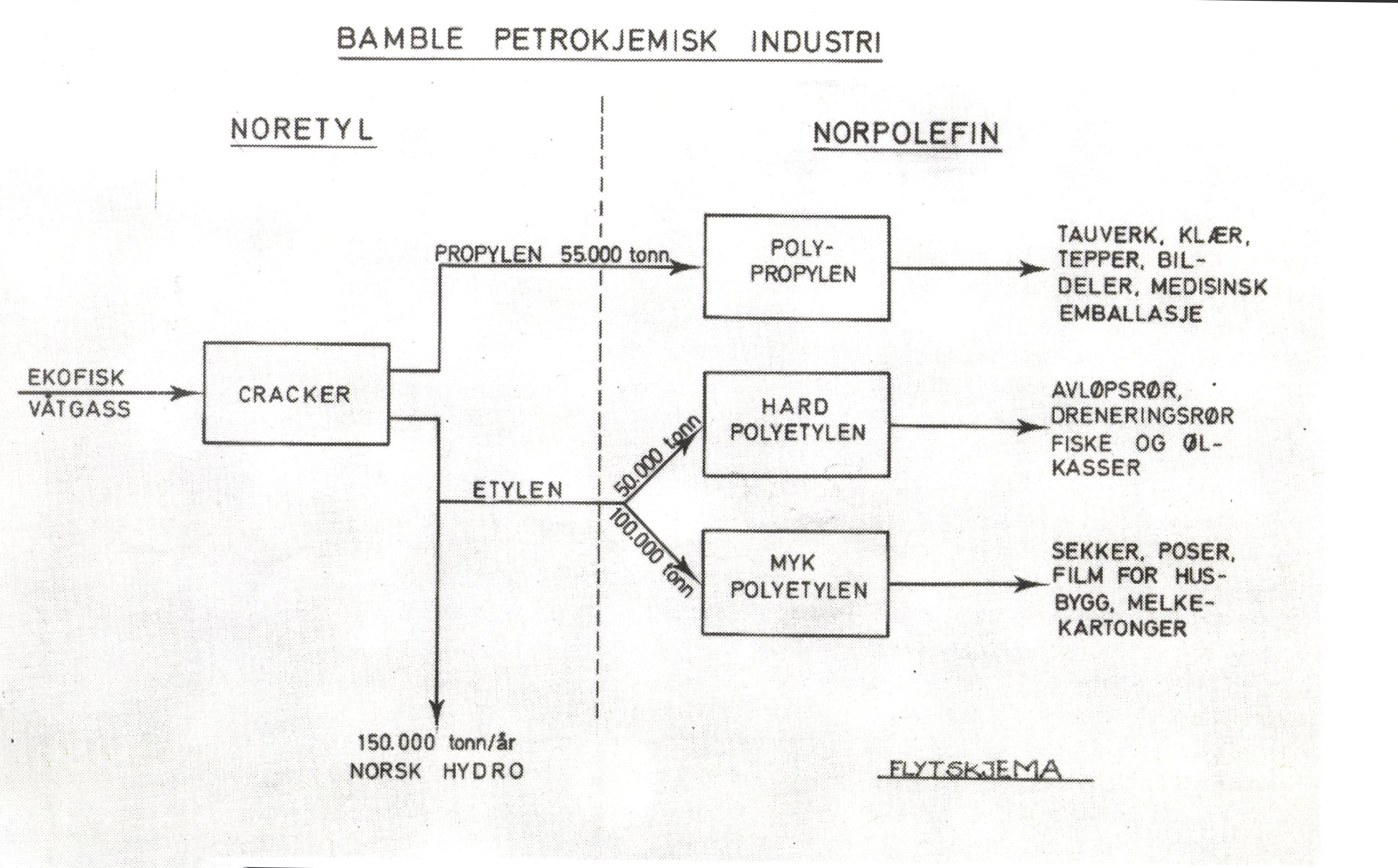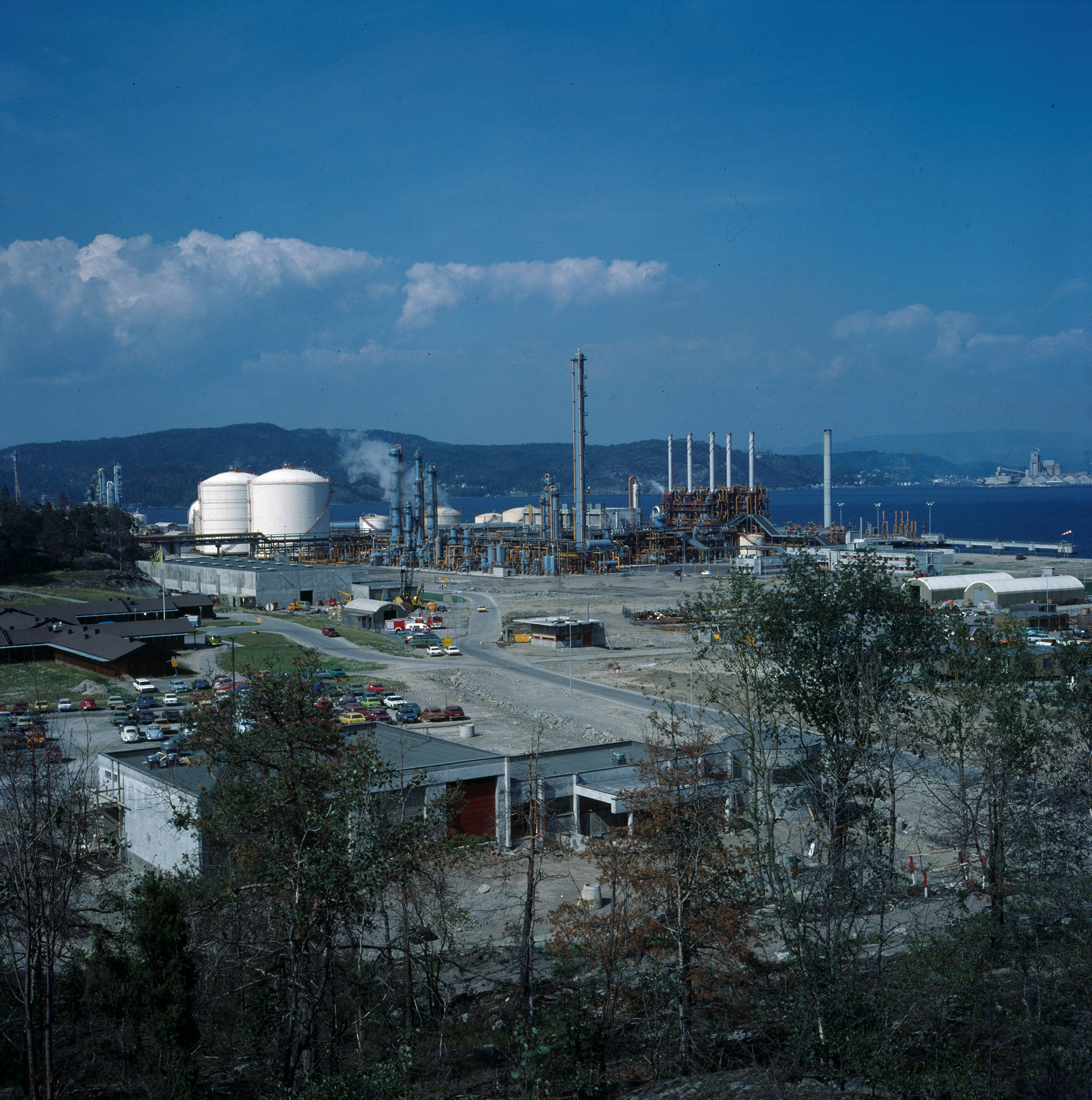Statoil’s route into petrochemicals

The market for petrochemical products was expanding in the early 1970s. World petroleum supplies were good after 1945. This was a cheap raw material used not only for motor fuels but also to create a number of products which could be mass produced. Fractions from the petrochemicals sector provided 90 per cent of the components in plastics, synthetic rubber, artificial fibres for clothing, paint, varnish, antifreeze and detergents – all of them used daily in industry and every household. Petrochemicals experienced a formidable expansion during the 1950s and 1960s, first in the USA and then in Europe and Japan. Around 1970, demand for such products looked like continuing to grow.
Hydro sees the opportunities
Norway’s Norsk Hydro company had begun petrochemicals production based on imported feedstock long before oil and gas were discovered on the NCS. With the aid of cheap Norwegian hydropower, it produced ammonia as an input for manufacturing fertiliser which was largely exported. The company had been making this at its Herøya plant south of Oslo since 1929.[REMOVE]Fotnote: Blindheim, Ulf, 20 February 2018, “Petrokjemi”, Store norske leksikon, https://snl.no/petrokjemi, accessed 31 March 2020.
When Norway became an oil producer from the Ekofisk field in 1971, Hydro wanted to retain this business for itself – now based on feedstock from the NCS. Abundant supplies of offshore petroleum meant that the product range could be expanded and lay the basis for new domestic industry. That called for studies and, eventually, political decisions.
As early as February 1972, Hydro initiated a preliminary project with Norway’s Borregaard on building a petrochemical plant in Norway to be based on NGL from Ekofisk.
Although Norwegian petroleum policy demanded that oil and gas from the NCS should primarily be landed in Norway, that rule was waived for Ekofisk. Crossing the 300-metre-deep Norwegian Trench between the field and the Norwegian coast with an oil pipeline was not technically feasible at the time. Instead, the Storting (parliament) voted on 26 April 1973 to allow the Phillips group of Ekofisk licensees to pipe the crude oil and NGL to Teesside in the UK and the gas to Emden in Germany.
As compensation for this permission, the licensees and the Norwegian government began negotiations on delivering feedstock to industry in Norway. An agreement signed on 30 August 1973 entitled the government to opt for NGL deliveries over a 15-year period to a petrochemical plant at Teesside or a port in southern Norway. It had until 1 July 1974 to decide between these. Deliveries would not begin for at least four years after signing the deal.[REMOVE]Fotnote: Johnsen, Arve, Utfordringen. Statoil-år: 70.
Norwegian industrial companies were not interested in a petrochemicals plant at Teesside. The point was to build industry at home. Negotiations were therefore pursued to get the Phillips group to pay for freighting the NGL from Teesside to the UK, which it accepted.[REMOVE]Fotnote: https://ekofisk.industriminne.no/nb/hjem/ The feedstock contract with the licensees was considered gilt-edged – and several industrial and oil companies indicated their interest in exploiting the opportunity it offered.

Saga and Statoil put in bids
But this was not a free-for-all. The government wanted to control the process. The day after the Storting decision, the negotiating committee for new industrial measures was tasked with studying how the option agreement with the Phillips group should be exploited. Chaired by director general Odd Gøthe at the Ministry of Industry, this cross-ministry body was to make its recommendations by the autumn.
Saga Petroleum, Norway’s newly established private oil company, now took action to enable it to invest in petrochemicals. Saga Petrokjemi A/S & Co was established in May 1973 together with the Aker group, Dyno Industrier, Elkem Spigerverket, Hafslund and Årdal og Sunndal Verk. Saga also initiated talks with Hydro on a possible collaboration.
Statoil then entered the fray. CEO Arve Johnsen, who had worked with petrochemicals at Hydro, was convinced that this was “an important industrial high ground where Statoil should be involved as early as possible”.[REMOVE]Fotnote: Johnsen, Arve, op.cit: 72. His vision was that the company should be fully integrated across all oil industry sectors, from exploration, via exploration and production, to processing and sale of petroleum products. Petrochemicals formed part of this vision.
On 1 June 1973, the Statoil board resolved that the company should communicate its interest in participating in the study of a joint Norwegian petrochemical project based on Ekofisk NGL. The management wrote to the industry ministry that “it must be right that the company is not only a producer of petroleum as feedstock, but also becomes a integrated company”. Statoil would contact Hydro/Borregaard and Saga Petrokjemi with the aim of participating on a equal basis so that each had a one-third interest.[REMOVE]Fotnote: https://media.digitalarkivet.no/view/22486/28. This was a bold move, which would not necessarily find support with the private companies or the government.[REMOVE]Fotnote: Ibid.
During the late summer and early autumn, Statoil chair Jens Christian Hauge and Johnsen held several meetings with the Hydro and Saga managements, talking alternately to Johan B Holthe and Torvild Aakvaag at the former and Otto Grieg Tidemand and Martin Siem at the latter. But Hydro in particular did not feel that one-third each was a natural division of interests.
The milieu in Oslo was not large, and Johnsen – who had been a junior minister at the industry ministry – talked frequently at this time with Gøthe. His impression after these conversations was that the civil servant – whose committee held the key to Statoil’s role in the petrochemical project – was not convinced about the company’s involvement. In Gøthe’s view, Statoil knew too little about petrochemicals. Johnsen’s counter-argument was that the company’s organisation was under development, and thereby flexible for taking on additional assignments.[REMOVE]Fotnote: Johnsen, Arve, op.cit: 70.
Nor had Ola Skjåk Bræk, the Liberal industry minister in the minority non-socialist coalition, envisaged any special role for Statoil in this industry – and gave clear expression to that view. As the smallest and most recent of the oil companies, it was the underdog in the struggle for power over the exploitation of the Ekofisk LNG and a possible petrochemical collaboration.
Fortunately for Statoil, the general election of September 1973 led by a narrow margin to a change of government, with Labour and the Socialist Left securing 74 seats to the non-socialists 77. Trygve Bratteli formed his second Labour government with Ingvald Ulveseth as industry minister.
On 16 October 1973, Skjåk Bræk’s last day in office, the negotiating committee presented its proposals for the petrochemicals sector.[REMOVE]Fotnote: Ibid: 71.
Fraught talks on petrochemicals
“Much would have looked different in Norway’s oil and gas sector, and not least in petrochemicals, if the general election in 1973 had yielded a different result,” Johnsen has written in his memoirs.
Ulveseth was prepared to give Statoil a very different role in petrochemicals than his predecessor had envisaged. On 2 November, he asked the company to chair talks on this sector with Hydro and Saga. His goal was that the three companies should collaborate on utilising the government’s option contract for the Ekofisk NGL. Hauge chaired the 10-day negotiation.
An extraordinary meeting of the Statoil board was held on 8 November to discuss the issue, and revealed that differences of opinion prevailed among the directors. The Conservative representatives, led by Vidkunn Hveding, maintained that a Saga/Hydro/Statoil collaboration must not get in the way of the best possible technical-economic solutions. Particular account had to be taken of Hydro’s existing facilities. Doubts were also expressed about whether it was right of Statoil to give priority to petrochemicals when these were less profitable than production and sale of crude oil.[REMOVE]Fotnote: Minutes, board meeting, Den norske stats oljeselskap a.s, 8 November 1973. But neither Hauge and Johnsen allowed such objections to hamper further progress in the negotiations. The goal now was to get Hydro and Saga to sing the same tune.
One of the main conclusions of the negotiating committee was that the petrochemical plants should be located in Bamble local authority in Telemark county. Hydro had acquired the Rafnes farm, covering 120 hectares, close to its existing Herøya facilities and well suited to establishing new industrial activity.
It was otherwise agreed that Hydro, with its experience, should operate the Bamble installations. A large and expensive plant was envisaged, with substantial capacity. The cracker, which occupied a central place in the process, called for a high level of technical expertise.
This unit would convert the NGL components – ethane, propane and butane – into gaseous products such as ethylene, propylene and so forth. These substances in turn form the basis for producing a number of plastic products.
During the negotiations, it was proposed that Hydro should own three-sixths of the cracker, with Statoil receiving two-sixths and Saga one-sixth. The NGL contract would be transferred to the new owner company. It was also proposed that vinyl chloride should be produced from ethylene and chlorine solely by Hydro. This product is used to make polyvinyl chloride (PVC), a plastic widely utilised for floor coverings, piping and so forth.
A polyolefin plant would be constructed in association with the cracker, with ownership split equally between the three companies and Saga as operator. This could produce such plastics as polyethylene and polypropylene, which are often used in household articles and packaging. Borregaard’s need for ethylene to produce vinyl acetate was to be specially accommodated.
It soon transpired that Hydro was unable to accept Statoil’s proposal, but insisted on a two-thirds holding in the cracker. “This disagreement meant that passions were very intense at times among all the affected parties,” Johnsen writes in his memoirs.[REMOVE]Fotnote: Johnsen, Arve, op.cit: 69. Nor was there quiet in the ranks on the Statoil board. Some of the directors felt that it did not have an adequate basis for reaching a decision on the issue.
Hauge made it absolutely clear that the board had earlier taken a decision in principle on the company’s participation in this petrochemical complex with a one-third share, and that this had been reported to the ministry. For its part, the Storting had indicated that the NGL contract with the Phillips group should be utilised to establish a Norwegian industrial collaboration, and the government had declared that state involvement would be substantial. On that basis, Hauge could only conclude that Statoil’s proposed collaboration agreement was in accordance with its goal and the board’s previous decision.
Since Hydro wanted not just half the cracker but two-thirds, which neither Saga nor Statoil would accept, further negotiations were pointless for the time being. It was now up to the government to tell the companies how they should collaborate.[REMOVE]Fotnote: Minutes, board meeting, Den norske stats oljeselskap a.s, 13 November 1973.
Hydro also had powerful allies who helped it to stand up to Ulveseth and Statoil. One example was environment minister Tor Halvorsen, who had a background in Hydro and believed the company should own more than 50 per cent of the ethylene plant.

Reluctant partner
When the negotiations came to a standstill, Ulveseth called in the chairs of Statoil and Hydro. The latter complained that he “had occasionally had the feeling of talking to deaf ears”. Was it really the intention that the state company should also pursue land-based operations, he asked? This was a quite clear ambition for Statoil, and the position remained equally deadlocked.[REMOVE]Fotnote: Borchgrevink, Aage Storm, Giganten, 2019: 46-47.
To make progress, the government drew up a memorandum which established the parameters for collaboration in the process. The industry ministry called for a response by 10 January 1974. Statoil’s board immediately resolved to respect these guidelines.[REMOVE]Fotnote: Minutes, board meeting, Den norske stats oljeselskap a.s, 13 December 1973. However, Hydro waited with its answer until after the deadline had expired.[REMOVE]Fotnote: Ibid, 10 January 1974.
On 25 January 1974, after a lengthy struggle on the division of roles, an agreement was finally signed between the government and the three companies. A management formula for the collaboration had then been found. Hydro and Saga would be operators under the management and control of the respective boards.[REMOVE]Fotnote: Ibid, 25 January 1974. The two companies established were I/S Noretyl for the cracker and I/S Norpolefin for polyolefins.
Saga and Statoil agreed that the plants should be co-located, and preferably at Bamble. Hydro preferred the cracker to be in Bamble and the polyolefin plant at Kårstø north of Stavanger. Nor was there full accord over the various agreements involved. Hydro had one solution, and its two partners another. That left it the decision to Ulveseth.[REMOVE]Fotnote: Ibid, 17 April 1974
The Storting finally voted on 1 June 1974 that the three companies would build a petrochemical complex in Bamble as agreed.
Bamble project
Design work for the Bamble plants made rapid progress. Hydro was in the driving seat with 51 per cent, and continued trying to keep Statoil (33 per cent) and Saga (16 per cent) at arm’s length.
As early as September 1974, Germany’s Linde AG received the NOK 700 million contract to build the cracker. With completion set for December 1976, Linde also undertook to spend a minimum of NOK 150 million on Norwegian goods and services.[REMOVE]Fotnote: Minutes, board meeting, Den norske stats oljeselskap a.s, 6 September 1974.
Where financing was concerned, the government assumed that the three companies could raise bond loans in the Norwegian market for part of the capital required. Each wanted to arrange its own funding. Both Hydro and Statoil aimed to issue bonds for their shares of Noretyl and Norpolefin.[REMOVE]Fotnote: Ibid, 6 September 1974. Norsk Hydro was not interested in any joint finance.[REMOVE]Fotnote: Ibid, item 13/74-2.

At peak, 1 300 people were employed on constructing the plant. That included 390 foreigners from Germany, France and the Netherlands. The facility made an impact on the landscape. Its tallest column was 70 metres high. A total of 2 500 piping welds were made. But not everything was visible above ground. Three large tunnels were constructed – one 13 kilometres long from the North Sea to Rafnes for seawater supply, another of four kilometres for pipelines to Hydro’s Herøya factories, and a dedicated storage cavern for propane. With a capacity of 100 000 square metres, this was blasted out 120 metres below sea level.
The ethylene plant at Rafnes was completed in the autumn of 1977, when it had about 160 permanent employees. Norway’s first polyethylene production and the Nordic region’s first output of polypropylene – soft and hard plastic respectively – began in 1978, but not initially with Ekofisk feedstock.
Much strike action in Britain during the late 1970s was part of the reason why it took longer than expected to complete the Teesside facilities.[REMOVE]Fotnote: Ibid, item 10/76-6: “I/S Noretyl – statusrapport”. The crude oil terminal was ready in 1975, but the NGL plant first became operational in March 1979. Reception capacity in 1979 was a million barrels per day.
Since 1979, NGL has been shipped from Teesside to Bamble by gas carrier – creating jobs and activity in Norway as intended by the original agreement.
arrow_backStatexStatfjord discoveredarrow_forward